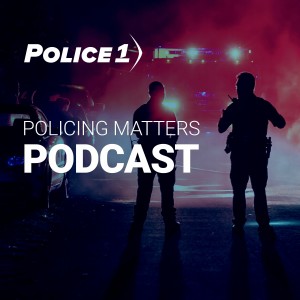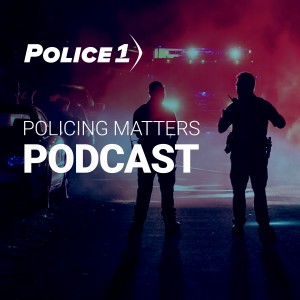
Talking the beat to cover what matters to you as an LEO. Join deputy chief Jim Dudley (ret.) every weekly as he sits down with law enforcement leaders and criminal justice experts to discuss strategy, challenges and trends in policing.
Episodes

Friday May 03, 2019
Friday May 03, 2019
During the annual conference of the International Law Enforcement Educators and Trainers Association (ILEETA 2019) in St. Louis, Policing Matters podcast co-host Doug Wyllie roamed the hallways and ran into countless law enforcement trainers and experts, some of whom were willing to sit down and talk about what they're teaching and what they're learning. In this podcast segment, Doug sits down with PoliceOne columnist Duane Wolfe, who discusses the importance of approaching officer wellness from the perspective of "totality of health."

Friday Apr 26, 2019
One officer‘s story of the day he put a gun to his head
Friday Apr 26, 2019
Friday Apr 26, 2019
During the annual conference of the International Law Enforcement Educators and Trainers Association (ILEETA) in St. Louis, Policing Matters podcast co-host Doug Wyllie roamed the hallways and ran into countless law enforcement trainers and experts, some of whom were willing to sit down and talk about what they're teaching and what they're learning. In this podcast segment, Doug sits down with PoliceOne columnist Duane Wolfe, who in 2012 wrote an article entitled "The day I put a gun to my head." Duane and Doug discuss the genesis of that article as well as the impact it has had on officers contemplating suicide.

Friday Apr 19, 2019
Friday Apr 19, 2019
During the annual conference of the International Law Enforcement Educators and Trainers Association (ILEETA) in St. Louis, Policing Matters podcast co-host Doug Wyllie roamed the hallways and ran into countless law enforcement trainers and experts, some of whom were willing to sit down and talk about what they're teaching and what they're learning. In this podcast segment, Doug sits down with Chief Bill Harvey to discuss some of the keys to multi-jurisdictional, multi-disciplinary response to large-scale events — both planned and unplanned — to ensure citizen and first responder safety.

Friday Apr 12, 2019
The importance of being a ‘predator‘ in a deadly confrontation
Friday Apr 12, 2019
Friday Apr 12, 2019
During the annual conference of the International Law Enforcement Educators and Trainers Association (ILEETA) in St. Louis, Policing Matters podcast co-host Doug Wyllie roamed the hallways and ran into countless law enforcement trainers and experts, some of whom were willing to sit down and talk about what they're teaching and what they're learning. In this podcast segment, Doug sits down with Lee Shaykhet, a renowned police trainer, who talks about predators versus prey—the importance of moving forward and doing what the subject doesn't expect in order to prevail in a deadly confrontation.

Friday Apr 05, 2019
How LE companies can better serve police
Friday Apr 05, 2019
Friday Apr 05, 2019
During the annual conference of the International Law Enforcement Educators and Trainers Association (ILEETA) in St. Louis, Policing Matters podcast co-host Doug Wyllie roamed the hallways and ran into countless law enforcement trainers and experts, some of whom were willing to sit down and talk about what they're teaching and what they're learning. In this podcast segment, Doug sits down with former editor of PoliceOne Scott Buhrmaster, who talks about how he continues to help law enforcement by helping the manufacturers and service providers that serve law enforcement be more effective in what they do.

Friday Mar 29, 2019
How the Below 100 program can save lives
Friday Mar 29, 2019
Friday Mar 29, 2019
During the annual conference of the International Law Enforcement Educators and Trainers Association (ILEETA) in St. Louis, Policing Matters podcast co-host Doug Wyllie roamed the hallways and ran into countless law enforcement trainers and experts, some of whom were willing to sit down and talk about what they're teaching and what they're learning. In this podcast segment, Doug sits down with Below 100 instructors Rod Rifredi and Kim Schlau, who discuss the five tenets of the Below 100 program—wear your belt, wear your vests, watch your speed, remember "what's important now" and complacency kills.

Friday Mar 22, 2019
Should police be allowed to seize guns from the mentally ill?
Friday Mar 22, 2019
Friday Mar 22, 2019
Following the mass shooting at Marjory Stoneman Douglas High School in Parkland, Florida, a great deal of attention was paid to the fact that the gunman had exhibited myriad signs of mental instability—hurting animals, threatening and/or fighting with other students, previous mental health treatment—that may have been enough for relatives or school authorities to ask law enforcement to keep him from possessing firearms. As of February 2019, more than a dozen states have laws on the books that allow local law enforcement to seize firearms from people diagnosed as mentally ill. In this podcast episode, Jim and Doug discuss the Constitutionality of such laws, and what they might mean in the larger context of the gun-control debate.

Friday Mar 15, 2019
Baltimore: A microcosm of de-policing in America
Friday Mar 15, 2019
Friday Mar 15, 2019
In Baltimore, it has been reported that from 2014 to 2017, dispatch records show the number of suspected narcotics offenses police reported themselves dropped 30 percent. The number of people they reported seeing with outstanding warrants dropped by half. The number of field interviews dropped 70 percent. This type of de-policing has emboldened criminals and crime now is on the rise. In September 2018, 37 people were killed in the city, making that the deadliest month in more than a year. Baltimore has had five police commissioners in four years. In this podcast segment, Jim and Doug discuss how things went from bad to worse in Charm City following the death of Freddie Gray and the subsequent anti-police protests.

Friday Mar 08, 2019
What the surge in swatting calls means for police
Friday Mar 08, 2019
Friday Mar 08, 2019
In mid-February someone called 911 in Myrtle Beach, South Carolina claiming to be Robert McCord, a reserve officer with the department. The caller told dispatchers he’d just shot his wife and was going to kill the rest of the people in the house. Police responded as one might imagine they would respond to such a call—they sent in SWAT to ensure the safety of innocents. McCord exited his home with hands held high above his head, walking slowly toward responders. The incident ended with nobody injured, but so-called "swatting" calls have been fatal on all too many occasions. In this podcast segment, Jim and Doug discuss what can be done to prevent swatting as well as how police investigate and charge people for making swatting calls.

Friday Mar 01, 2019
What the LEOSA Reform Act might mean for active and retired officers
Friday Mar 01, 2019
Friday Mar 01, 2019
In 2004, Congress passed the Law Enforcement Officers Safety Act (also known as LEOSA), which allows qualified active and retired officers to carry a concealed firearm in any jurisdiction in the United States—with certain exceptions and restrictions. Recently introduced legislation—the LEOSA Reform Act—would expand where current and retired officers can carry a concealed firearm, as well as reform the qualification standards for retired officers to ease superfluous burdens for anyone carrying in accordance with LEOSA. If passed, some of the hurdles put in place in states like New York, New Jersey and other places would come down. In this podcast segment, Jim and Doug discuss whether or not the LEOSA Reform Act will pass, and what it would mean for officers if it does.
